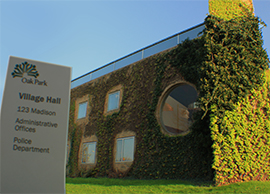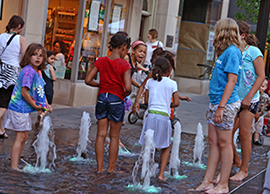Species diversity was the theme of tree planting in May, as Village foresters and contractors spread out across the Village to plant nearly 350 trees representing 36 different species.
Diversity is essential, officials say, because the more diverse an urban forest, the less susceptible it will be to outbreaks like Dutch elm disease and the emerald ash borer that have led to widespread tree losses across the community and the region.
In addition to its annual spring tree planting, the Village also schedules a fall planting in November when another 200 or so trees likely will be planted.
The majority of annual plantings replace trees removed after they became infected with Dutch elm disease or the emerald ash borer, but foresters also are seeing an increase in Norway maple and linden trees that have reached the end of their life spans and require removal.
When a tree is removed, the location is entered in the Village’s inventory of trees in the public way and a new tree is typically replanted within two seasons.
The Village Forester, a certified municipal arborist, manages when, where and what trees will be planted. While requests for specific species are considered, the Village cannot provide a list of available tree species from which a resident can select since site conditions and species availability vary greatly from season to season.
New trees typically are 10 to 15 feet tall with a two-inch trunk diameter and a 36-inch root ball. Each new tree is planted and mulched, and a watering bag attached that is refilled regularly during the first growing season.
Residents are urged to store the watering bags and use them in future years to help the trees on their parkways stay strong during their most vulnerable years.
Experience has shown that smaller trees transplant best in Oak Park’s urban environment. The cost and the chance of failure go up exponentially when transplanting larger trees, officials say, noting that within five years of planting, a two-inch and five-inch tree will look the same.
The Village maintains an inventory of trees in the public way that is updated regularly. The database is available online and residents can use it to identify trees on their parkways and throughout the Village.
At the time of the last comprehensive inventory in 2014, maple trees made up 24 percent of the tree population in Oak Park, followed by elm trees (11 percent), linden trees (10 percent) and oak trees (nine percent).
The goal for a healthy urban forest is to not have any species family make up more than 10 percent of the overall population. With this objective in mind, large quantities of oak, tulip, buckeye and pear trees are being planted this spring, while maple trees make up only a small fraction of the new arrivals.
In addition to caring for the nearly 19,000 trees growing on parkways throughout the village, the Village foresters also care for the bushes, shrubs and seasonal planters that are an important part of public landscaped areas.
Oak Park’s care of its urban forest has not gone unnoticed. In 2015, the Village was recognized as the state’s first municipal arboretum.
For more information on tree care in the Village visit www.oak-park.us/trees.
Spring Planting Inventory
Thirty six species of trees are scheduled to be planted in Oak Park in May. Here’s the breakdown and quantities of each:
Chinkapin Oak – 10
Red Oak – 10
Regal Prince Oak – 10
Sawtooth Oak – 10
Shingle Oak – 10
Scarlet Oak – 8
Heritage English Oak – 5
Shumard Oak – 5
Swamp White Oak – 5
Apple Serviceberry – 30
Tulip Tree – 22
Glenleven Littleleaf Linden – 10
American Sentry Linden – 5
Shamrock Linden – 5
Whitespire Birch – 20
Autumn Splendor Buckeye – 15
New Bradford Pear – 14
Seaside Alder – 12
Shawnee Brave Baldcypress – 12
New Horizon Elm – 10
Accolade Elm – 1
Black Tupelo – 10
Exlamation Londonplane – 10
Halka Pagodatree – 10
Happidaze Sweetgum – 10
Kentucky Coffeetree – 10
Northern Catalpa – 10
Siouxland Poplar – 10
Skyline Honeylocust – 10
Turkish Filbert – 10
American Yellowwood –5
Hardy Rubber Tree – 5
Kastura Tree – 5
Purple Robe Black Locust – 5
Red Pointe Maple – 5
Red Jewel Crabapple – 4
Visit www.oak-park.us/trees for more information on the care of Oak Park’s urban forest.










